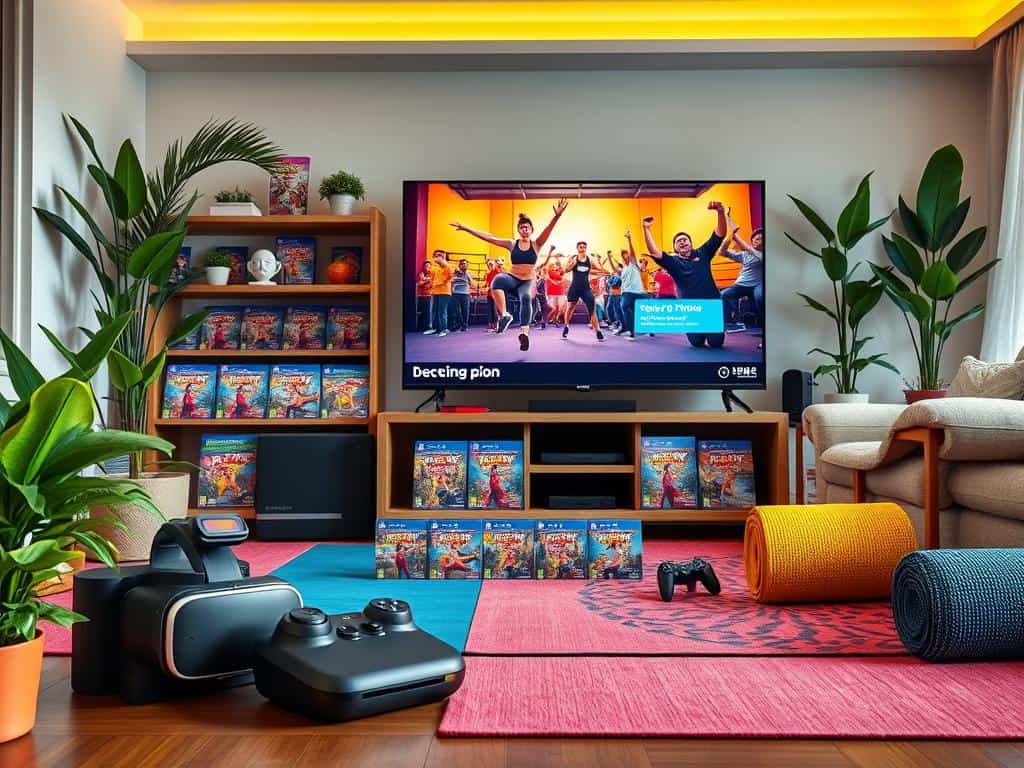Did you know tracking health in real-time boosts motivation? It does this through challenges, rewards, and letting us share our progress online. Exploring wearable fitness tech, it’s clear how it’s changing health monitoring. Before, we had simple step counters. Now, we have devices like fitness trackers and smartwatches with many features.
Today’s wearables are about more than counting steps. They check heart rates, count calories burned, and even look at how we sleep. By using this data, I can stay focused on my fitness goals. This helps me make good health decisions for better well-being. With these advancements, managing personal health has taken a big leap. It shows the future of staying fit is smart and informed movement.
Key Takeaways
- Most fitness wearables include basic features like pedometers and step counters.
- The majority offer heart rate monitoring functionality for more comprehensive health tracking.
- Advanced wearables can track calories and sync with food diaries for precise health management.
- Real-time tracking capabilities enhance motivation through social features and competitive workouts.
- These devices have evolved to monitor various health metrics, including blood oxygen levels and stress.
The Rise of Wearable Fitness Tech
Recently, the market for wearable health devices has changed a lot. It shows how people want to get better at staying healthy. Consumers are looking for tools that can improve their fitness journey.
Evolving Technology and Market Growth
There has been a big shift from simple fitness trackers to advanced wearable devices. These new devices don’t just count steps. They offer deep insights that make workouts better. For example, users can easily track effort points, calories, and effort percentages.
This shift is in line with the ACSM Worldwide Fitness Trends survey. Wearable technology has been a top fitness trend since 2016. It’s expected to stay popular until 2024.
Smartwatches are at the forefront of this change. More people are starting to use wearable tech. The number of smartwatch users is expected to keep growing. This shows how much people are interested in these devices.
Variety of Devices Available
There are many different wearable health devices on the market. They fit many lifestyles and health goals. Users can pick from simple bands to advanced ECG monitors.
For example, Wodify Pulse uses Myzone technology to monitor heart rates in real time. It gives clear details about workout intensity. The use of leaderboards in fitness classes encourages friendly competition. It keeps everyone motivated.
The growth in fitness technology is about more than just tracking. It helps build a community that keeps people coming back to gyms. Wearable devices have become key tools for both individuals and fitness pros.
Key Features of Wearable Fitness Tech
Fitness tech wearables offer cool features that help you manage your health better. They track your daily activities, letting you understand your health better. Tools like the Fitbit and Apple Watch pack many features into one device, crucial for wellness-focused folks.
Activity Tracking and Health Monitoring
At the heart of wearable tech is its awesome activity tracking ability. These gadgets count your steps, track calories burned, and monitor your sleep. They also check your heart rate, providing real-time health data during workouts and the entire day. This detailed tracking helps me make fitness goals and learn how my body reacts to different exercises.
Advanced Health Insights
Wearable tech is getting smarter, offering advanced health insights. Features like VO2 Max, stress levels, and how fast you recover are now standard. These help me tailor my workouts and get to know my body’s needs. As tech advances, we might even see features like blood sugar tracking, revolutionizing personal health management.
![]()
Benefits and Drawbacks of Wearable Fitness Tech
Wearable fitness technologies have changed how we manage our health. They make tracking our physical activities and sleep easy. This helps us control our health better. With wearables, you can set fitness goals and get alerts about health issues. They also provide useful data about your physical activities. This encourages a proactive approach to staying healthy.
Advantages for Personal Health Management
Today’s market has grown thanks to wearable trackers, smart glasses, and health-focused jewelry. These gadgets make users feel empowered and motivated to stay active. A 2019 study showed that these tools help health professionals keep an eye on patients. This helps improve health results. These devices hold users accountable and offer insights based on data.
Potential Limitations
But, wearable fitness tech isn’t perfect. Problems like wrong data and constant charging can bother users. They can be uncomfortable, cause distractions, and might not work with all phones. There are also worries about who can see your data and obsessing over tracking. Some may depend too much on these gadgets and ignore doctors or their own body’s signals.
Conclusion
The future of fitness lies in wearable technology. It has changed how we approach our health and exercise routines. These gadgets offer valuable insights into our health. They help people make better choices for their lifestyle.
Devices like Fitbits, Garmins, and Apple Watches have evolved. They used to just count steps. Now, they track many aspects of our health. Things like heart rate, sleep patterns, and even detecting irregular heartbeats are standard. This shows how important wearables are for a full view of our well-being.
I believe wearable tech will continue to shape our health and fitness. With new features and AI, these devices will only get better. They will play a big part in making our society more aware of health. This will help us all live better and more active lives.



